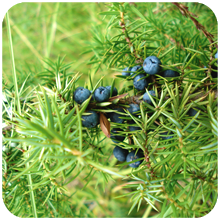
The species grows throughout the Carpathian at 700-1400 m, often in shrubs and bunches in meadows, pastures, groves, potentially grow in bare soils. It is a conifer shrub or a columnar tree. Increases and extends on the earth, 20 cm in height and 20-30 cm in width. In Europe, it grows in the form of a tree. The leaves are sharp and grouped, hard wedge-like conifers with a strong smell. The young leaves are sharper in shape, like a pin. The mature ones are wider. Juniper bark is thin, scaly, often exfoliated into thin strips. The fruits look like tomato cherry, which turns to a blackish- blue after ripening.
Chemical composition – Contain 0.8-1.5% volatile oil. The volatile oil is composed of d-α-pinene, camphene, cadinene, 1-4-terpineol and small amounts of other sesquiterpene alcohols, β-pinene, dipentene, myrcene, Juniperine, which is a mixture of triglycerides and other substances- junenol, which is 10 – methyl 1- methylene -7 – isopropyl -8 decalol.
Properties – Diuretic, antiseptic, carminative, analgesic, healing, sudorific, stomachic, bronchodilator, antitussive, bronchisl antispastic, hair tonic.
Recommendation – Acne, sores, alopecia, angina, ascites, renal and rheumatic problems, acute and chronic bronchitis, cancer, diabetes, diarrhea, dyspepsia, rash, dropsy, chronic hepatitis, leucorrhea, vegetative lesions, psora.
This plant is incorporated in natural remedy PROSTATOSALM.




